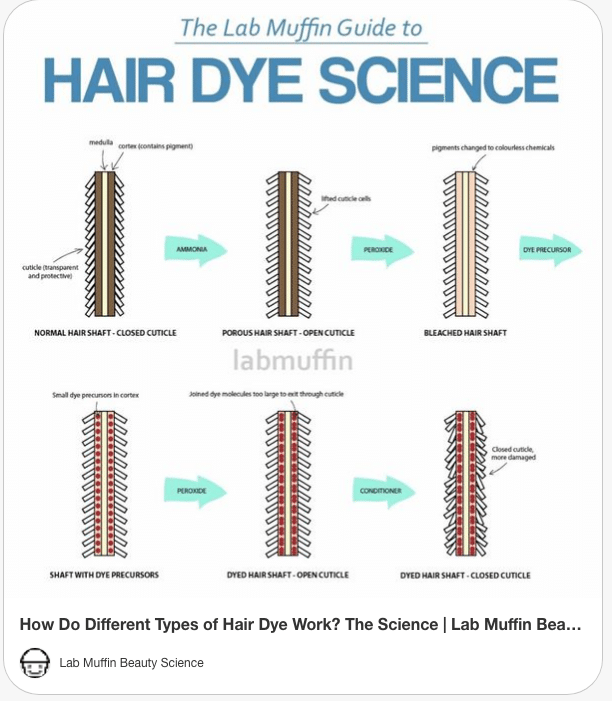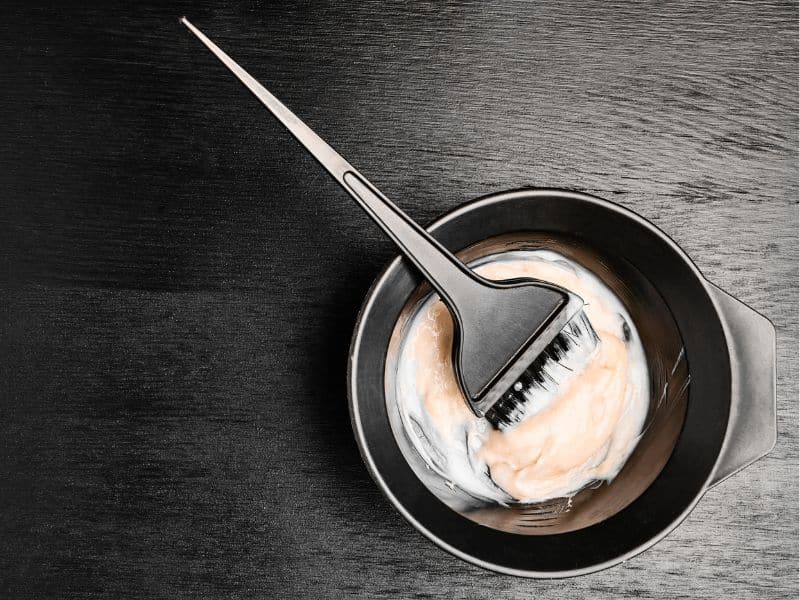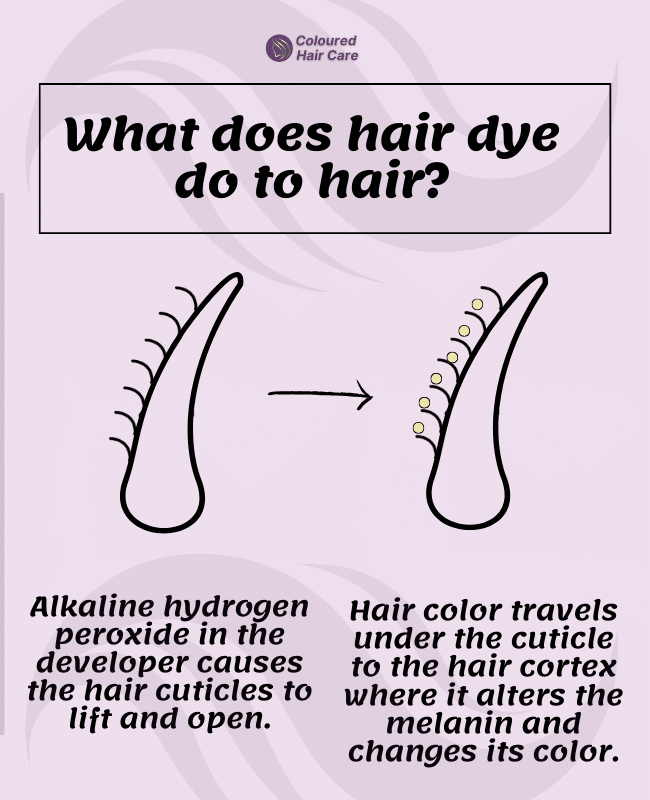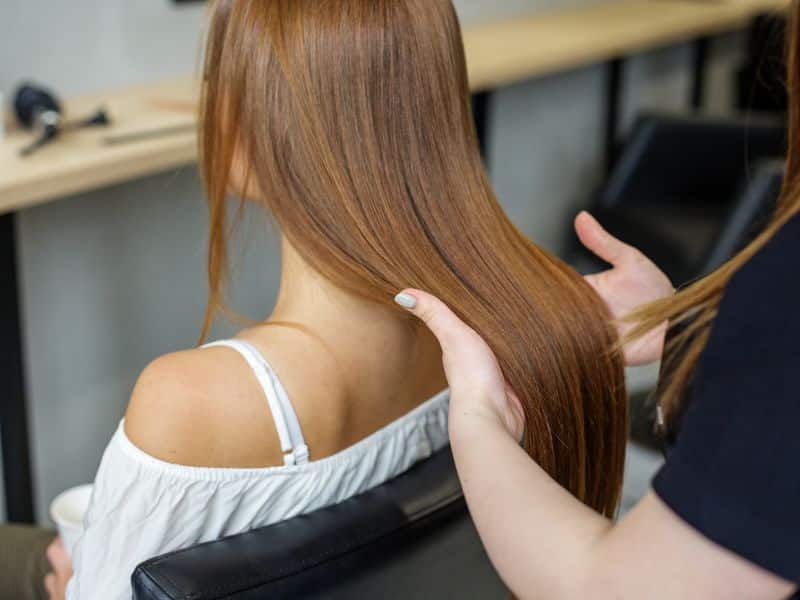Whether you’re sprucing up those roots, swinging back to your natural shade, switching up your style, or even aiming for that dazzling unicorn look, we all adore the endless possibilities that come with hair dye.
But have you ever wondered what’s really happening when you’re transforming your locks into that super pretty shade?
What exactly does hair dye do to our hair? And, more intriguingly, how does it work? Stick with me, and let’s unravel this together!
There’s more to hair dye than just slapping on a new color.
The science behind getting that perfect shade is pretty nifty, and believe it or not, it’s also the reason why it can be such a challenge to wash out that bold choice you made last month!
That’s exactly why I’m here – to walk you through everything you need to know about hair dye, from its colorful chemistry to its clever workings. So, are you ready to become a bit of a hair dye whiz? Let’s get started!
TLDR: Key Takeaways – How Does Hair Dye Work?
Hair dye works by interacting with the three layers of hair: the cuticle (outer layer), cortex (where color is held), and medulla (innermost part). Hair dyes mainly affect the cuticle and cortex depending on the type of dye you use:
- Temporary Dye: Coats the hair surface, washes out quickly (1-2 shampoos).
- Semi-Permanent: Partially penetrates hair shaft, lasts 4-12 washes.
- Demi-Permanent: Penetrates more than semi-permanent, lasts 12-24 washes, no ammonia.
- Permanent: Fully penetrates, changes hair color permanently, contains ammonia and peroxide.
Table of Contents
- TLDR: Key Takeaways – How Does Hair Dye Work?
- The Science of Hair Structure
- Watch and learn: How does hair dye work?
- The Different Types of Hair Dye
- The Chemical Process of Hair Dyeing
- How does Hair Dye Work with Different Hair Types?
- Balancing Beauty and Care: The Pros and Cons of Hair Dyeing
- Tips for Maintaining Hair Color
- FAQs: All About Hair Dyeing
- Parting words
- Our Research & Review Process
The Science of Hair Structure
Understanding your hair’s anatomy is key to getting why and how hair dye does its magic. So, let’s break down what a strand of hair is all about.
The Cuticle
Think of the cuticle as the outermost defender of your hair strand. It’s made up of layers of tiny, overlapping scales, kind of like roof shingles. The cuticle’s job is to protect the inner parts of your hair.
But it’s not just about defense; it also plays a big part in how your hair looks and feels. When the cuticle is healthy and the scales lie flat, your hair looks smooth and shiny. When we dye our hair, the dye has to get past this protective barrier to work.
Expert Insights
“Hair color lifts the cuticle, altering the hair in a way that will never completely revert back to it’s natural virgin state.”
Laura Lee Mason, Salon owner, colorist, stylist
The Cortex
Now, meet the cortex. This is where the action happens when you dye your hair. The cortex is nestled right under the cuticle and it’s where you’ll find all the natural pigments that give your hair its color.
These pigments are called melanin. When you apply hair dye, it’s the cortex that absorbs the new color, changing your hair’s appearance. The health and condition of the cortex play a huge role in how vibrant and long-lasting your dye job will be.
“Ammonia is used in hair color. This chemical elevates the pH of the hair, and in doing so, the cuticle relaxes and lifts up. Once the hair cuticle is raised then the color pigments can enter the hair.”
Grant Romundt, Founder of Scissorboy.com
The Medulla
Finally, there’s the medulla, the innermost part of the hair strand. To be honest, it’s a bit mysterious. The medulla doesn’t play a significant role in hair dyeing. In some people’s hair, it’s not even present. Think of it as the quiet, enigmatic center of the hair strand.
So, when you’re coloring your hair, what you’re really doing is working with these three layers, especially the cuticle and cortex, to change its appearance.
Each part plays its role in making sure the color looks great and that your hair stays healthy. Understanding this can help you choose the right products and techniques to get the color you want, while keeping your hair in top shape.
Here’s a great infographic by those beauty boffs at Labmuffin that shows the science behind how hair dye works.

Watch and learn: How does hair dye work?
Here’s a great video tutorial we always refer to that guides you through the science behind how har dye works in an interesting way.

The Different Types of Hair Dye
Let’s talk about the different types of hair dye and how each one works with your hair. There’s a whole spectrum of options, from a quick color change to a long-lasting transformation.
Temporary Hair Dye
The Quick Fling: Temporary hair dye is your hair’s playful, no-strings-attached friend. It’s there for a good time, not a long time.
You apply it, show off its flashy colors, and then wave goodbye after a single wash. It’s perfect for those spur-of-the-moment decisions when you want to rock a bold color for just a day or two.
- Popular Brands: Manic Panic, L’Oréal Paris Colorista Spray, Kristin Ess Rose Gold Temporary Tint.
- How Long It Lasts: Typically washes out in 1-2 shampoos.
Semi-Permanent Hair Dye
The Casual Date: Semi-permanent dye is like a casual dating phase for your hair. It sticks around a bit longer, letting you enjoy your new color for a few weeks.
It’s the kind of dye that says, “Let’s hang out for a while, but I’m not ready to commit.” Ideal for those who want to experiment with color without diving too deep into the commitment pool.
- Popular Brands: Arctic Fox, Adore, Good Dye Young.
- How Long It Lasts: Generally lasts for about 4-12 washes.
Demi-Permanent Hair Dye
The Steady Relationship: Demi-permanent dye is your hair’s steady, reliable partner. It’s in it for a more significant stretch, giving you that lasting connection without the lifetime commitment.
It’s the perfect middle ground, saying, “I’m here for a good time, and maybe a long time, but I’m not permanent.” This dye is great for those wanting a more noticeable change than semi-permanent, but aren’t quite ready to say ‘forever’ just yet.
- Popular Brands: Wella Color Charm, Clairol Natural Instincts, Ion Demi Permanent Hair Color.
- How Long It Lasts: Can last around 12-24 washes.
Permanent Hair Dye
The Lifetime Commitment: Permanent hair dye is the “till your roots do us part” kind of deal. It’s the full commitment, changing your hair color for the long haul.
This dye means serious business, offering a total transformation that’s there to stay. It’s perfect for those who are sure about their color choice and ready to commit to it fully.
- Popular Brands: Garnier Nutrisse, L’Oréal Paris Excellence Créme, Revlon ColorSilk.
- How Long It Lasts: Permanent change, lasts until hair grows out or is re-dyed.
Each type of hair dye brings its own unique vibe to your hair. From a fleeting flirtation to a lasting bond, there’s a dye for every mood and moment.
Understanding these types helps you pick the perfect partner for your hair-coloring journey.

The Chemical Process of Hair Dyeing
Let’s get to the chemistry of permanent hair dyeing, a fascinating process that involves several steps and key chemicals like ammonia and hydrogen peroxide.
Step #1 Opening the Cuticle:
The first step in hair dyeing is to open up the cuticle, which is the outer layer of your hair. This is necessary for the dye to penetrate the hair shaft.
Ammonia is often used in this process. It raises the hair’s pH to an alkaline state, which causes the cuticle scales to lift and open.
Step #2 Bleaching the Hair
Hydrogen peroxide plays a crucial role here. It’s used to bleach the natural pigment of the hair, lightening it so the new color can bond effectively.
Peroxide reacts with melanin (the natural pigment in hair), breaking it down and lightening the hair’s color. This step is particularly important for achieving lighter shades.
Step #3 Adding Dye Precursors
After opening the cuticle and lightening the hair, small precursor molecules are added. These precursors are not yet the final color.
They soak into the cortex (the middle layer of the hair), getting ready for the next chemical transformation.
Step #4 Reacting Precursors to Form the Dye
This is where the actual dyeing happens! The precursor molecules react with each other, often with the help of hydrogen peroxide, to form large dye molecules.
These new, large dye molecules are the ones that give your hair the new color. They are too big to easily wash out, thus making the color change effective.
Closing the Cuticle
Finally, the cuticle needs to be closed back down to seal in the new color and protect the hair shaft.
This is usually done with an acidic conditioner, which brings the hair’s pH back to normal, helping the cuticle scales to flatten and close.

How does Hair Dye Work with Different Hair Types?
Hair dye interacts differently with various hair types and textures, and understanding this can help in achieving the best results while minimizing potential issues like color fading and damage.
Fine Hair
Fine hair tends to absorb color quickly but is also more prone to damage.
It’s important to use gentler dyes and avoid over-processing. Semi-permanent or demi-permanent dyes are often more suitable for fine hair.
Thick Hair
Thick hair may require more dye and longer processing times to achieve the desired color.
Due to its density, thick hair can handle stronger formulations, but care should still be taken to maintain hair health.
Curly or Textured Hair
Curly or textured hair can be naturally dry, so it’s essential to use moisturizing and nourishing dyes.
This hair type may also show color differently due to its unique light-reflecting properties, so color choice is crucial.
Chemically Treated or Previously Dyed Hair
Hair that has been previously dyed or chemically treated is more porous and may absorb color more intensely.
Extra care is needed to avoid uneven color and further damage. Strand tests and patch tests are highly recommended.
By understanding how hair dye interacts with different hair types and addressing common concerns, you can achieve a beautiful color that suits your unique hair while keeping it as healthy and vibrant as possible.
Balancing Beauty and Care: The Pros and Cons of Hair Dyeing
Like most beauty treatments, hair dyeing comes with its own set of benefits and drawbacks. Let’s take a closer look at the pros and cons of hair dyeing, alongside some tips to maximize the benefits and reduce the risks.
| Pros of Hair Dyeing | Cons of Hair Dyeing |
|---|---|
| Enhanced Appearance | Risk of Damage |
| – Transformative color change. | – Over-processing can lead to hair breakage. |
| – Can cover grays for a more youthful look. | – Frequent dyeing may weaken hair strands. |
| Boost in Confidence and Self-Expression | Risk of Allergic Reactions |
| – Allows for personal expression. | – Some may experience skin irritation. |
| – Boosts self-esteem with a new look. | – Patch tests recommended to avoid allergies. |
| Enhanced Hair Texture | Color Fading |
| – Some dyes can make hair appear thicker. | – Color may fade with washing and sun exposure. |
| – Can add shine and dimension to hair. | – May require frequent touch-ups. |
| Experimentation with Trends and Styles | Maintenance Requirements |
| – Opportunity to experiment with new looks. | – Requires regular upkeep for best appearance. |
| – Ability to follow and try out current trends. | – Might need specific products to maintain color. |
To minimize the cons of hair dyeing, it’s important to:
- Choose the Right Product: Select hair dyes suited to your hair type and condition. Opt for quality products with nourishing ingredients.
- Professional Consultation: If unsure, consult a hair professional before dyeing, especially for drastic changes or if you have damaged hair.
- Proper Aftercare: Use color-protective shampoos and conditioners, avoid excessive heat styling, and regularly condition your hair.
- Sensible Dyeing Frequency: Limit the frequency of dyeing to reduce damage. Consider semi-permanent or demi-permanent dyes as gentler alternatives.
- Conduct Patch Tests: Always do a patch test, especially if trying a new brand or if you have sensitive skin, to prevent allergic reactions.
Tips for Maintaining Hair Color
- Use Color-Safe Shampoos and Conditioners: Switch to hair care products specifically formulated for color-treated hair. These products are gentler and help preserve color while minimizing fading.
- Avoid Frequent Washing: Washing your hair too often can strip away color. Try to extend the time between washes, and consider using dry shampoo on no-wash days.
- Cold Water Rinse: When you do wash your hair, use cold or lukewarm water. Hot water can open up the hair cuticle, leading to faster color fading.
- Limit Heat Styling: Excessive use of heat styling tools can damage dyed hair. When using heat styling, always apply a heat protectant spray to minimize damage.
- Use Color-Enhancing Products: There are various products available, like color-depositing shampoos, that can help maintain or even enhance your hair color between dyeing sessions.
- Regular Trimming: Regular trims help in removing split ends and keep your hair looking healthy.
FAQs: All About Hair Dyeing
Q: How often should I dye my hair to avoid damage?
It’s generally recommended to wait at least 4-6 weeks between hair dyeing sessions.
If you’re using permanent dye, you might need to touch up your roots every 4-8 weeks. For semi-permanent or demi-permanent dyes, you can wait a bit longer. Always consider the health of your hair before deciding to re-dye.
Q: Can I dye my hair at home or should I go to a salon?
You can dye your hair at home, especially if you’re using semi-permanent or temporary dyes.
For more complex changes, like going significantly lighter or attempting a major color change, it’s safer to visit a professional stylist to minimize the risk of damage and ensure the best results.
Q: Is it safe to dye my hair if it’s already damaged?
If your hair is significantly damaged, it’s best to avoid further dyeing until it’s healthier.
Over-dyeing can lead to increased breakage and hair loss. Consider using conditioning treatments and consult a hair care professional for advice on repairing your hair.
Q: How can I make my hair color last longer?
To extend the life of your hair color, use color-safe shampoos and conditioners, wash your hair less frequently, use cold water for rinsing, and protect your hair from the sun and heat styling.
Additionally, using color-enhancing products can help maintain the vibrancy.
Q: Can hair dye cause allergic reactions?
Yes, some individuals may have allergic reactions to certain ingredients in hair dye, most commonly PPD (p-Phenylenediamine).
It’s important to perform a patch test 48 hours before applying a new dye, even if you’ve dyed your hair before.
Q: Is it possible to dye my hair without using chemicals?
Yes, there are natural hair dye alternatives like henna, which is a plant-based dye.
However, natural dyes usually offer a more limited range of colors and might not produce as lasting or dramatic results as chemical dyes.
Parting words
We’ve journeyed through the vibrant and dynamic world of hair dyeing, uncovering the science, types, and care involved in transforming our hair color.
From understanding the structure of hair and the chemistry behind dyeing to navigating the various types of dyes and their effects, we’ve explored how hair dye can be a powerful tool for personal expression and style enhancement.
Remember, whether you’re going for a subtle tint or a bold transformation, the key is to choose the right type of dye and apply it safely!
References and Further Reading
For those interested in delving deeper into the topics we’ve covered or seeking additional information, here’s a list of the sources used in this article. These references are great for further reading and provide credible insights into the world of hair dyeing.
- Lab Muffin Beauty Science – How Do Different Types of Hair Dye Work? The Science Provides a detailed scientific explanation of how hair dye works, including the structure of hair and the chemistry of dyeing.
- ThoughtCo – Hair Color Chemistry: How Hair Coloring Works Offers an overview of the history and chemistry behind hair coloring.
- HolleewoodHair – How Hair Dye Works: The Interesting Science Behind Hair Color A comprehensive guide to the science behind hair dye, explaining different types of dyes and their effects on hair.
- All Things Hair – Hair Dyeing 101: Basic Steps for Coloring Your Hair at Home Discusses various types of hair dyes and offers tips for dyeing hair at home.
- Bellatory – How Hair Dye Works Explores the role of key chemicals in hair dyeing and how they affect the hair structure.
Found your perfect shade? We’d love to see it! Tag us on Instagram @colouredhaircare or Facebook and share your hair dye success stories. Looking for more hair care tips? Check out How to Look After Colored Hair: 11 Expert Secrets For Long-Lasting Color.

Our Research & Review Process
To ensure our recommendations are as comprehensive and reliable as possible, we’ve undertaken an extensive research effort.
We cite scientific evidence and journals, collect real user reviews and gather impartial perspectives from hair stylists, users, and experts in the field.
Additionally, we conduct hands-on testing by using products and applying hair dyes not only on our own locks but also on real human hair extensions and hair pieces of different hair type, textures and lengths.
This rigorous approach allows us to provide you with insights into which products genuinely live up to their promises.
As always – please consult with a professional hair colorist or stylist for advice on how to color your own hair at home. It’s different for everyone!
